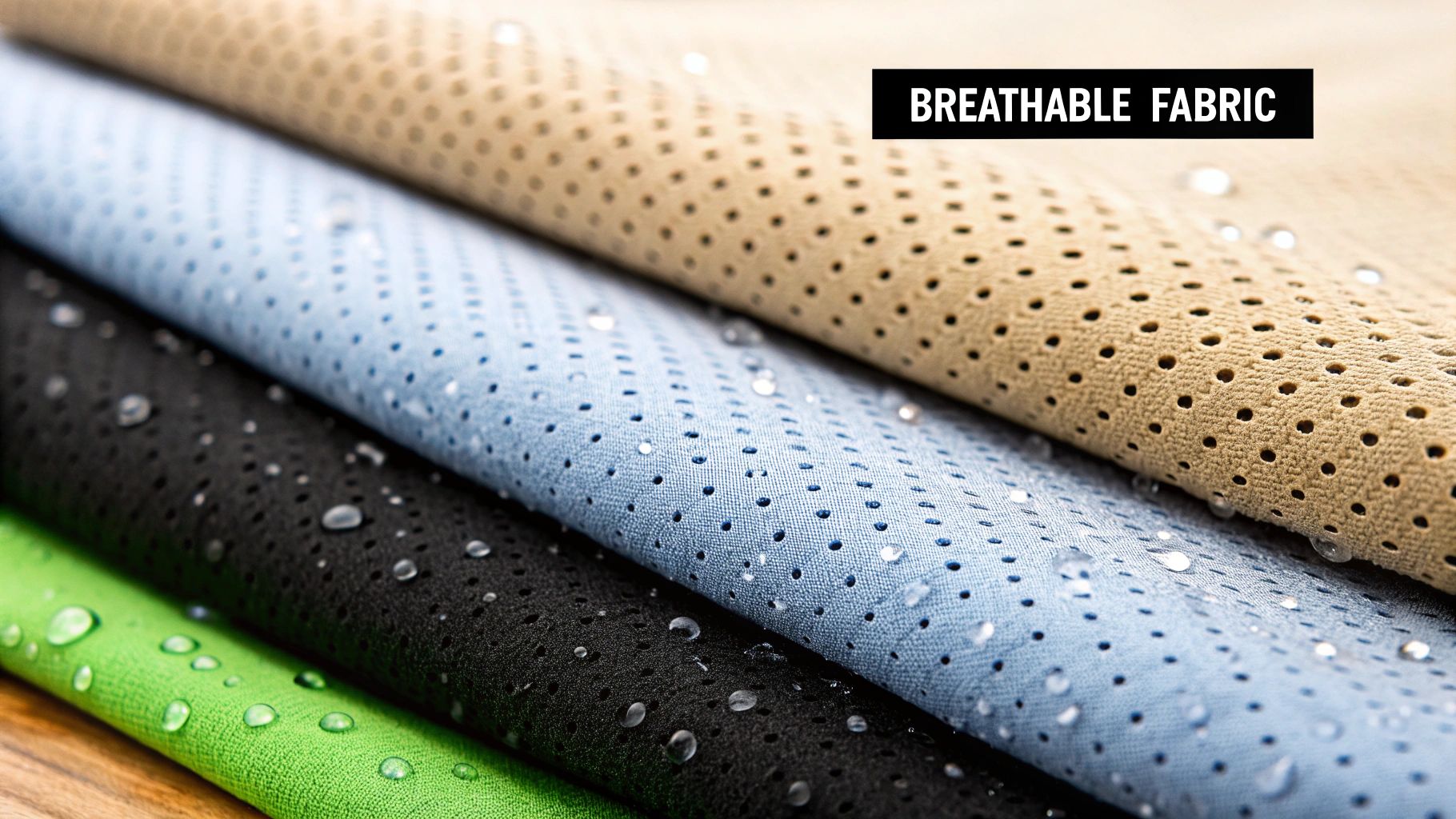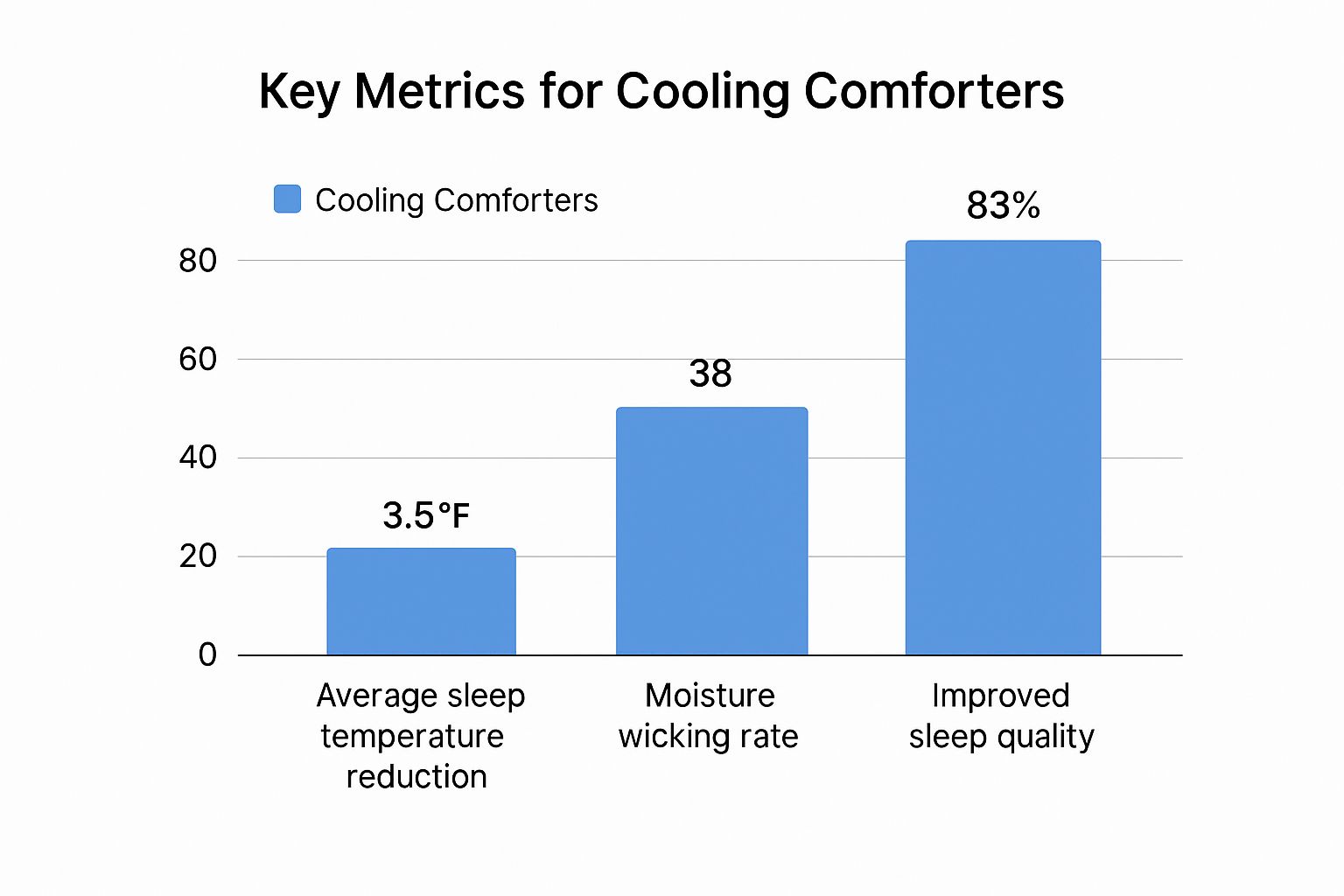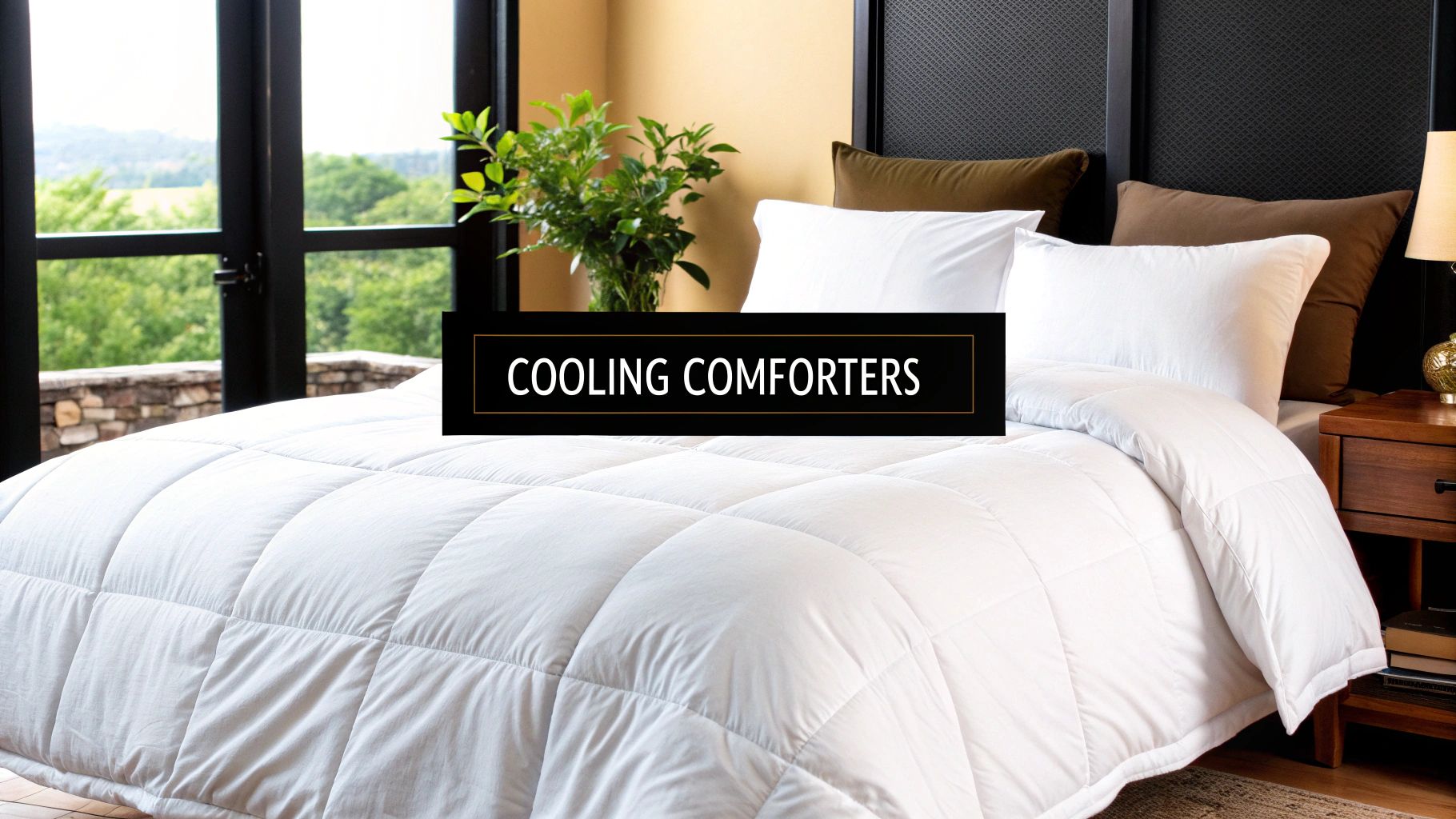Tired of waking up in a sweaty tangle of sheets? You are not alone. A cooling comforter is designed to end that nightly battle, using breathable, moisture wicking materials to help regulate your body temperature for a deep, uninterrupted sleep. It is the perfect answer for anyone who finds their traditional duvet just a bit too toasty.
Why Your Duvet Could Be Making You Overheat
It is a familiar story. You fall asleep feeling wonderfully cosy, only to wake up a few hours later, clammy and hot, desperately kicking off the covers. If that sounds like your typical night, your traditional duvet is probably the reason why.
Many standard duvets, particularly those filled with dense synthetics or heavy down, are brilliant insulators. They are designed to trap your body heat, which is fantastic during a cold winter snap. But that same quality becomes a problem on milder nights or for those of us who naturally run a bit warm.
All that trapped heat creates a stuffy little microclimate under the covers. Your body temperature climbs, leading to the dreaded night sweats. This constant struggle for thermal comfort shatters the deep, restorative stages of sleep, leaving you feeling groggy and drained the next day. It is a frustrating cycle, to say the least.
The Problem with Trapped Heat
Think of your standard duvet as a thick winter coat. It is great outdoors in January, but you would not wear it inside. Most conventional fillings and fabrics lack breathability, meaning air cannot circulate to whisk excess warmth away from your body. This is a crucial difference when you begin to understand what duvet covers are and how the outer fabric interacts with what is inside.
This is not just a niche problem anymore, especially as UK summers seem to be getting warmer. It is no surprise that we are seeing a surge in people looking for temperature regulating bedding. Google Trends data shows that UK searches for “cooling blankets” peaked in June, and searches for “cooling mattresses” also grew steadily into the summer. The pattern is clear, people are actively seeking a cooler night’s sleep.
A Better Way to Sleep
A cooling comforter tackles the problem from a completely different angle. Instead of just trapping heat, it is engineered to manage it. These clever comforters use advanced materials that actively promote airflow and pull moisture away from your skin, keeping you comfortably dry all night.
The difference this makes is profound.
- Deeper Sleep: By keeping your body at a stable, comfortable temperature, you are far less likely to be jolted awake.
- Waking Up Refreshed: More time in restorative sleep means you wake up feeling genuinely rested and ready to face the day.
- Year Round Comfort: While they are a godsend in summer, many cooling comforters are versatile enough for year round use, especially for hot sleepers.
Making the switch is a simple, practical step towards ending the nightly fight with your own body heat. It is an investment in consistent, high quality rest, so you can feel your best every single day.
How Cooling Comforters Really Work

It can feel a bit like magic, but the secret behind a great cooling comforter is actually just clever, practical science. They do not have tiny fans or frosty technology hidden inside. Instead, they work with your body’s natural temperature system through a combination of smart materials and thoughtful design.
These comforters are built on three main principles that work together to create a perfectly balanced sleeping environment. By mastering breathability, moisture management, and sometimes even active temperature regulation, they solve the overheating problem that makes so many traditional duvets unbearable for warm sleepers.
Let's look into exactly how these features deliver a noticeably cooler and more comfortable night's sleep.
Superior Breathability Prevents Trapped Heat
First and foremost, a cooling comforter has to let air move freely. Think of it like opening a window in a stuffy room. Your standard duvet often uses tightly woven fabrics and dense fillings that trap air, creating an insulated bubble of your own body heat that gets hotter and hotter through the night.
Cooling comforters, on the other hand, use materials specifically chosen for their breathable structure. Fabrics like natural cotton, bamboo, and Tencel have weaves that allow air to circulate effortlessly. This continuous airflow carries excess heat away from your body before it can build up, stopping that stifling, overheated feeling from ever starting.
It is a simple but incredibly effective first line of defence against waking up in a sweat.
Smart Moisture Wicking for a Dry Night
Even with great airflow, we all perspire a little during the night. That is where the second key principle comes into play, moisture wicking. If you have ever worn high performance sportswear, you will know exactly how this works. The fabric pulls sweat away from your skin and spreads it out, allowing it to evaporate quickly.
This is precisely how a cooling comforter keeps you feeling dry and comfortable.
- Drawing Moisture Away: Specialised fibres actively pull perspiration from your skin to the comforter's outer layer.
- Quick Evaporation: Once on the surface, the moisture evaporates into the air, creating a subtle cooling effect.
- Preventing Clamminess: This whole process stops that damp, sticky feeling that so often ruins sleep, especially on warmer nights.
By managing moisture so effectively, these comforters ensure your body's natural cooling process works as it should. You stay comfortably dry, which is essential for maintaining a stable temperature all night long.
This proactive approach is a huge step up from traditional bedding, which can often absorb sweat and just leave you feeling damp. A dry bed is a comfortable bed, and this technology is central to making that happen.
Active Thermal Regulation Technology
While breathability and moisture wicking are brilliant on their own, some of the most advanced cooling comforters take things a step further with active thermal regulation. This is where truly smart materials enter the picture, working dynamically to maintain the perfect temperature balance for your body.
The most common technology used for this is called Phase Change Material (PCM). These are microscopic capsules integrated into the fabric or fill that can absorb, store, and release heat. You can think of them as tiny, rechargeable batteries for temperature.
Here is a simple breakdown of how they work.
- Absorbing Heat: As your body warms up, the PCMs absorb this excess energy, turning from a solid to a liquid inside their tiny capsules. This process actively draws heat away from you, creating a cool sensation.
- Releasing Heat: If your body temperature dips later in the night, the PCMs do the opposite. They solidify again, releasing the stored heat to keep you from getting chilled.
This constant, subtle adjustment creates a personal microclimate that stays within the ideal range for deep sleep. It is a dynamic system that responds directly to your body’s needs, ensuring you are never too hot or too cold. This intelligent regulation is what makes these comforters so effective at delivering uninterrupted, restorative rest.
Choosing the Best Cooling Comforter Material
When it comes to finding the right cooling comforter, the material is everything. The fabric and the fill are the real heart of its performance, defining how it feels against your skin and, crucially, how well it keeps you from overheating.
Think of it like choosing your favourite jumper, it is a deeply personal decision. Some of us swear by the crisp, classic feel of cotton, while others fall for the silky smooth drape of bamboo or Tencel. Then you have the high tech synthetics, engineered from the ground up for maximum cooling. Getting to know the personality of each material is the key to finding your perfect sleep partner.
Natural Fibres for Breathable Comfort
There is a reason natural materials are such a popular choice for bedding. They offer a fantastic blend of breathability and softness, and many come with impressive eco friendly credentials. They simply work with your body, not against it, to help create a balanced and comfortable sleep environment.
Here are a few of the most popular natural choices you will come across.
-
Breathable Bamboo: Famous for its incredibly soft, almost silky feel, bamboo fabric is a brilliant choice for a cooling comforter. It is exceptionally breathable and a master at wicking moisture away from your skin, which is essential for staying dry and comfortable all night. Plus, it is naturally hypoallergenic, making it a kind option for sensitive skin.
-
Silky Tencel™: Tencel, the brand name for lyocell, is crafted from sustainably sourced wood pulp. It has this wonderfully luxurious, smooth feel that drapes beautifully and is well regarded for its superb temperature regulating abilities. Its moisture absorption is second to none, helping to guarantee a cool, dry night.
-
Crisp Cotton: Cotton is the timeless classic, loved for its natural breathability and familiar softness. For the best experience, look for long staple varieties like Egyptian or Pima cotton. Their finer, stronger threads create a much smoother and more durable fabric. A high quality cotton in a percale weave feels crisp and cool to the touch, a bit like slipping into a freshly laundered shirt.

A Quick Comparison of Cooling Comforter Materials
To help you decide, here is a quick look at how these popular materials stack up against each other. Each has its own unique strengths, so the "best" one really depends on what you prioritise for a good night's sleep.
| Material | Key Benefit | Feel | Best For |
|---|---|---|---|
| Bamboo | Superior moisture wicking | Silky, soft, and smooth | Hot sleepers who value a gentle, soft touch. |
| Tencel™ | Excellent temperature control | Luxurious and drapey | Eco conscious buyers wanting a premium feel. |
| Cotton | Classic breathability | Crisp, light, and airy | Those who love a traditional, fresh feel. |
| Synthetics | Engineered moisture management | Varies, often smooth | Anyone needing durability and easy care. |
Ultimately, this table is just a starting point. Your personal comfort is what matters most, so think about which combination of benefits sounds most appealing for your needs.
Advanced Synthetic Fabrics
While natural fibres have their charm, do not overlook modern synthetics. These materials often bring a whole different set of advantages to the table, as they are specifically engineered for performance, durability, and easy care routines.
Many of these fabrics, like advanced microfibre or specialised polyester blends, are designed with microscopic channels that actively pull sweat away from your body, making them incredibly effective at keeping you dry. They also tend to be very resilient and can handle frequent washing without losing their shape or softness, a huge plus for busy households.
So, natural or synthetic? It often boils down to what you value most. If top tier moisture control and low maintenance care are your priorities, an advanced synthetic could be your perfect match. To explore this topic further, take a look at our comprehensive guide to the best bed sheet materials.
Sustainability and Your Choice
For many of us, the environmental story behind our purchases is just as important as the product itself. The good news is that you do not have to compromise. Many cooling comforters are made with sustainability at their core.
Materials like Tencel, for instance, are produced in a closed loop system that recycles water and solvents, drastically reducing its environmental footprint. Organic cotton is grown without harsh pesticides, and bamboo can be a highly renewable crop. This focus is clearly resonating with UK shoppers; recent market analysis shows a 30% annual growth in demand for sustainable bedding. This shift proves that more and more of us are looking for comfort that aligns with our values.
When you choose a comforter made from sustainable materials, you are not just investing in better sleep for yourself. You are also supporting practices that are kinder to the planet, ensuring a better future for everyone.
What About the Filling?
The outer fabric is only one half of the equation. What is inside your comforter is just as crucial for staying cool. A lightweight, breathable fill is absolutely essential to prevent heat from getting trapped.
Here are the most common fills you will find.
-
Down Alternative: Most cooling comforters use a high quality down alternative fill, like microfibre or a specially engineered polyester. These synthetic fills are designed to mimic the lovely, lofty softness of traditional down but without its tendency to trap heat. They are also hypoallergenic and much easier to care for.
-
Wool: It might sound surprising, but wool can be an incredible fill for a cooling comforter. While it is a natural insulator, it is also wonderfully breathable and fantastic at wicking moisture. This allows it to keep you comfortable in both warm and cool conditions.
-
Silk: For a truly luxurious option, a silk filled comforter is naturally hypoallergenic and a brilliant temperature regulator. It is lightweight and drapes closely to your body, helping it manage heat and moisture effectively all through the night.
How to Find Your Perfect Cooling Comforter

Choosing the right cooling comforter goes a lot deeper than just picking a colour that matches your bedroom. It is a genuine investment in your sleep, and a few small details can be the difference between a decent purchase and the one that finally gives you a peaceful night's sleep.
Now that we have covered the different materials and tech, let's get practical. By paying close attention to things like the Tog rating and the quality of the stitching, you can confidently pick a comforter that actually lives up to its cooling claims. Think of this as your inside guide to spotting real quality and making a smart choice.
The good news is, you are not alone in this search. The UK home bedding market is set to grow at a forecasted rate of 6.5% each year for the next decade, largely because we are all paying more attention to our sleep health. This boom means more innovation and better options for everyone. If you are interested, you can explore more about these market trends and what they mean for bedding.
Understanding the Tog Rating
The Tog rating is just a straightforward, standardised way to measure how warm a duvet or comforter will be. It tells you how well the bedding traps heat, so for a cooling comforter, you will want to aim for a number at the very bottom of the scale.
- 1.0 to 4.5 Tog: This is the sweet spot. It is the ideal range for a summer or dedicated cooling comforter, offering just enough weight to feel comforting without trapping any heat.
- 7.0 to 10.5 Tog: This is your typical "all seasons" weight. It is fine for most of the year but will likely feel too warm for hot sleepers during the summer.
- 13.5 Tog and above: These are strictly for the coldest winter nights, the exact opposite of what you are looking for.
Simply put, a low Tog rating is the clearest sign that a comforter is built for breathability and will help you stay comfortable when things heat up.
A common mistake is thinking any lightweight comforter will be cool. Always check the Tog rating. It is the only reliable indicator of how well it manages heat, ensuring you get the breathable comfort you need.
Why Construction Quality Matters
How a comforter is actually put together is just as crucial as the materials it is made from. Quality construction ensures the filling stays put, preventing those annoying clumps and cold spots that can ruin a good night's sleep.
The gold standard here is baffle box stitching. This technique creates a grid of individual fabric pockets across the comforter, each holding an equal, measured amount of fill. It is a clever design that keeps everything perfectly distributed, even after a spin in the washing machine.
A well made comforter does not just feel better; it lasts longer, making it a far better investment in the long run. It guarantees that every single inch of your bed offers the same consistent, cool comfort.
Reading Labels and Reviews Like a Pro
When you are ready to buy, the product label and customer reviews are your two best friends. They help you see past the glossy marketing and understand what you are really getting.
Here is a quick checklist to use while you shop.
- Check the Materials: Does the label clearly state the fabric and fill? Look for specifics like "100% Tencel™ Lyocell" or "bamboo viscose," not vague descriptions.
- Look for Certifications: An OEKO-TEX® certification is a great sign. It means the product has been independently tested and is free from harmful substances, giving you extra peace of mind.
- Scan for Keywords in Reviews: When sifting through customer feedback, search for words like "breathable," "cool to the touch," "lightweight," and "wicks away sweat." This shows you if the comforter is delivering on its promises for real people.
- Note Comments on Durability: Pay attention to reviews mentioning how the comforter holds up after washing. This is one of the best clues you will get about its long term quality and value.
By combining this knowledge of materials, Tog ratings, and construction with a sharp eye for labels and reviews, you are all set to find the cooling comforter that will truly transform your sleep.
Caring for Your Cooling Comforter
You have invested in a better night's sleep, so it only makes sense to look after your cooling comforter. The good news? It is much easier than you might think. A little bit of care goes a long way in protecting the delicate fibres and smart technology that work so hard to keep you comfortable.
Always start with the care label. Just like you would not treat a silk shirt like a pair of jeans, different cooling materials need different handling. Natural fibres like bamboo can be quite delicate, and comforters with phase change materials often have specific instructions to keep their cooling magic intact.
Simple Washing and Drying Steps
Keeping your comforter clean is crucial for maintaining its breathability and moisture wicking power. Thankfully, for most cooling comforters, a gentle machine wash is all it takes.
Here is a simple routine to follow.
-
Choose a Gentle Cycle: Stick to the delicates or gentle setting on your washing machine. The slower spin cycle is much kinder to the fabric, stitching, and fill.
-
Use Cool Water: Always wash in cool or cold water, never hot. High temperatures can seriously damage the fine fibres responsible for the cooling effect and may even cause natural materials to shrink.
-
Select a Mild Detergent: A gentle, pH neutral detergent is your best bet. Steer clear of harsh chemicals, bleach, and especially fabric softeners. These can leave a residue that clogs the fabric’s pores, ruining its ability to wick away moisture.
When it comes to drying, think low and slow. You can use a tumble dryer, but only on the absolute lowest heat setting. A great trick is to toss in a few wool dryer balls to help fluff up the comforter and ensure it dries evenly. If you have the space, line drying is even better, it is the gentlest method of all.
Make sure your comforter is 100% dry before it goes back on your bed or into storage. Even a hint of dampness can lead to mustiness and cause the filling to break down over time.
Storing Your Comforter Properly
If you swap out your cooling comforter for a warmer duvet in the winter, how you store it matters. The goal is to keep it safe from dust and moisture while still letting the fabric breathe.
A large, breathable cotton storage bag is perfect for the job. Avoid plastic bags or containers at all costs; they trap moisture, which can lead to musty smells and yellowing. Find a cool, dry spot like the top of a wardrobe or a linen cupboard to keep it safe until you need it again.
For a more detailed walkthrough, you can explore our Snuggle Comforter care guide for extra tips. Follow these simple steps, and your comforter will keep delivering that cool, refreshing sleep season after season.
Still Have Questions About Cooling Comforters?
It is completely normal to have a few questions lingering. Choosing the right bedding is a personal decision, and you want to get it right. So, let’s tackle some of the most common queries we hear about cooling comforters.
Think of this as a quick chat to clear up any final doubts, helping you feel totally confident you are making the right choice for a better, cooler night’s sleep.
Can a Cooling Comforter Really Keep Me Cool All Night?
Yes, a good one absolutely can. It is not like an air conditioner that actively chills the air; instead, it works by managing the microclimate right there under the covers with you. Its main jobs are to breathe and to pull moisture away from your body.
This simple one two punch prevents that stuffy build up of heat and humidity that jolts you awake in the middle of the night. By helping your body regulate its own temperature more efficiently, the comforter keeps you in that comfortable sweet spot, leading to deeper, more restorative sleep.
Are Cooling Comforters Only for Summer?
Not at all. While they are an absolute godsend in the warmer months, many people find they are perfect all year round. This is especially true if you are a naturally hot sleeper, share a bed with a partner who runs at a different temperature, or deal with night sweats for any reason.
The magic is that these comforters are designed for temperature regulation, not just one way cooling. They adapt, helping to stop you from getting too hot or too cold. For a lot of us, that balanced comfort is exactly what we need, no matter what the calendar says.
A common misconception is that "cooling" means you will feel cold. In reality, a good cooling comforter is about maintaining a stable, comfortable temperature, preventing the extreme peaks and troughs that disrupt your sleep. It creates balance, not a chill.
What Is the Difference Between a Cooling Comforter and a Cooling Blanket?
That is a great question, because the terms can get a bit muddled. They generally refer to two different things, designed for slightly different needs.
Here is a simple way to think about it.
- Cooling Comforter: This is a proper, filled piece of bedding, much like a traditional duvet. The difference is it has a lower Tog rating and is filled and covered with breathable, moisture wicking materials. It gives you that lovely, substantial feel of a comforter, just without the trapped heat.
- Cooling Blanket: This is usually a single layer of fabric. It might be a weighted blanket or made from a special textile that feels cool to the touch. It is a much lighter option, perfect for those who just want a thin covering on the hottest nights.
Basically, if you love that cosy, tucked in feeling but cannot stand the heat that comes with a standard duvet, a cooling comforter is your answer.
Do Cooling Comforters Need a Special Cover?
You can certainly use them without one, but popping on a duvet cover made from a breathable material is a smart move. A cover protects your comforter from dirt and body oils, which means you will not have to wash the comforter itself as often, helping it last much longer.
The trick is to pick a cover that works with the comforter, not against it. Look for covers made from the same kinds of materials we have been talking about.
- Tencel™
- Bamboo
- High quality, long staple cotton (especially a percale weave)
- Linen
Using a heavy, non breathable cover like flannel or cheap polyester would completely defeat the purpose. It is like putting a winter coat over high performance sportswear, you would just trap all the heat the comforter is working so hard to release. So, if you go for a cover, make sure it is a team player.
Are They Suitable for People with Sensitive Skin?
Absolutely. In fact, many of the best materials used in cooling comforters are naturally hypoallergenic and incredibly gentle on the skin. Fabrics like bamboo and Tencel are known for their silky smooth fibres that are far less likely to cause irritation.
On top of that, by keeping your sleeping environment drier and preventing excess sweat, these comforters can help reduce the very conditions that aggravate skin issues like eczema. To be extra sure, always look for an OEKO-TEX® certification. This seal of approval guarantees the product has been tested and is free from harmful chemicals, giving you total peace of mind.
How Long Do Cooling Comforters Last?
The lifespan really comes down to the quality of the comforter and how well you look after it. A high quality one, made with durable materials and solid construction like baffle box stitching, can easily last for five to ten years, sometimes even longer with proper care.
Following the care instructions on the label is the single most important thing you can do. Gentle washing, using mild detergents, and avoiding high heat will preserve the fibres and any of the cooling tech woven into the fabric. A little bit of care goes a long way in ensuring your comforter provides cool, comfortable nights for years to come.
Ready to stop overheating and start sleeping soundly? Explore the beautiful and practical bedding solutions at Morgan and Reid and discover how the right materials can transform your nights. Find your perfect comforter today.



Share:
How to Choose the Perfect Duvet
Find the Perfect Extra Large Comforter for Your UK Bed